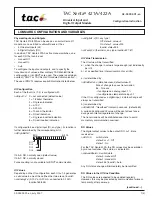
Rev 17.2/12-21
MT-10TDC-HV-C: #35094
1
INTENDED FOR USE BY SKILLED
PROFESSIONALS • READ AND
UNDERSTAND BEFORE OPERATING
OPERATING
INSTRUCTIONS
908 W. Main • P.O. Box 368
Laurel, MT USA 59044
800-548-7341 (phone)
406-628-8231 (phone)
406-628-8354 (fax)
www.WPG.com
KEEP FOR FUTURE REFERENCE
MANUAL TILTER 1500,
DC-VOLTAGE, 3 SCFM
Model number: MT1010TDC
Serial number: ___________________________ (to locate, see serial label on the product)


































